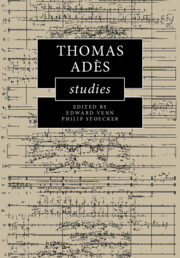Book contents
- Thomas Adès Studies
- Thomas Adès Studies
- Copyright page
- Dedication
- Contents
- Figures
- Tables
- Music Examples
- Online Materials
- Contributors
- Preface
- Acknowledgements
- Notes on the Text
- 1 ‘Chronically volatile’
- 2 Performing Adès
- 3 ‘Fountain of Youth’, ‘River of Meaning’
- 4 ‘Oh brave new Caliban’
- 5 Chaconnes in the Music of Adès
- 6 Closing the Circle?
- 7 A World in Constant Motion
- 8 Musique automatique? Adèsian Automata and the Logic of Disjuncture
- 9 Narrating the Dance of Death
- 10 Hearing Voices in Adès’s Operas
- 11 The RICH Logic of Adès’s The Exterminating Angel and The Tempest
- 12 Sonic Allegory in Adès’s The Exterminating Angel
- Bibliography
- Index
9 - Narrating the Dance of Death
Morality and Social Critique in Adès’s Totentanz
Published online by Cambridge University Press: 18 November 2021
- Thomas Adès Studies
- Thomas Adès Studies
- Copyright page
- Dedication
- Contents
- Figures
- Tables
- Music Examples
- Online Materials
- Contributors
- Preface
- Acknowledgements
- Notes on the Text
- 1 ‘Chronically volatile’
- 2 Performing Adès
- 3 ‘Fountain of Youth’, ‘River of Meaning’
- 4 ‘Oh brave new Caliban’
- 5 Chaconnes in the Music of Adès
- 6 Closing the Circle?
- 7 A World in Constant Motion
- 8 Musique automatique? Adèsian Automata and the Logic of Disjuncture
- 9 Narrating the Dance of Death
- 10 Hearing Voices in Adès’s Operas
- 11 The RICH Logic of Adès’s The Exterminating Angel and The Tempest
- 12 Sonic Allegory in Adès’s The Exterminating Angel
- Bibliography
- Index
Summary
In this chapter I argue that Adès’s Totentanz, for mezzo-soprano, baritone and orchestra, functions as a musical commentary on the allegory of the Dance of Death. Translating into music Bernt Notke’s famous fifteenth-century frieze, which depicted wraith-like skeletons taking part in a Dance of Death with members of society in strictly descending order of societal importance, Adès’s Totentanz is an act of narration which reveals a message of social critique centred on the corrupting materialism and hierarchical structure of society. Adès sheds light on his priorities as (musical) storyteller through a number of narrative strategies, including foreshadowing, intertextual references, topical allusions, pacing and proportion and musical characterisation. Chains of thirds and fifths, serving as narrative motives and functioning as symbols for the ideas of damnation, salvation and human suffering, link together the music for many characters, and signifiers of death and the demonic, such as the Dies irae, permeate the music.
- Type
- Chapter
- Information
- Thomas Adès Studies , pp. 188 - 212Publisher: Cambridge University PressPrint publication year: 2021

